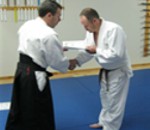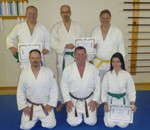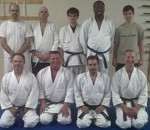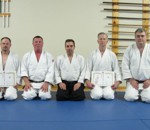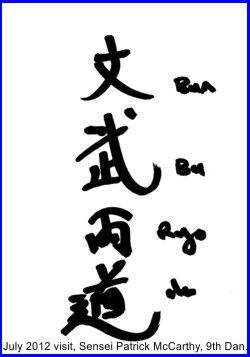Posted June 8, 2020 by Sensei Black
" Aikido encourages peace but is not absence of conflict. Yoshinkan Aikido teaches the ability to handle conflict by peaceful means. "
Posted November 30, 2015 by Rob Moran
What is Ukemi?
So many people think that ukemi is about falling down, how to fall down,
about being thrown. Well of course it is, but it is also about so much
more.
It is about engagement, both physical and energy (which starts way before
the physical and last way after).
It is about intent, about attack and continuation of the attack. It is
about looking for the opening to take back control after you have been
unbalanced, about keeping up the attack while keeping yourself safe. It is
about sticking in there as long as possible to try to find a hole,so if
your attacker makes a mistake you haven't baled out and are no longer
around.
It is constant awareness of all that is around you
So many people just take falls,. Yeah it's fun and some people may think
it looks cool, but many times it is not ukemi. And after the big jump the
person either lies there or gets up but without awareness, so that the
person who just through uke could in fact step on or attack from behind.
This awareness, this connection with your surroundings is what I find
missing in most practice.
One should never take his eyes off of his opponent and if you did you
would have a large opening where the attacker could hurt you. Sometimes
it might be necessary to take a break fall. But for those rare instances,
we must practice such falls but when practicing, try not to get sucked
into the I wanna take cool looking falls.
Always remembering that both the defender and the attacker are always
attacking each others center, both must keep themselves safe, both must
find a way to take the others balance, and to keep the connection. Both
must find a way to take the others balance, but more importantly to keep
the connection. Always engaged, always connected.
This is the meaning of Ukem
Sensei Black
Be Like Water
August 13, 2014
Of course the quote above comes from Bruce Lee, the legendary martial artist, poet and philosopher. While it has been re-quoted often, few actually understand what Lee meant by that, and the story of how it came about.
I want to revisit it here, because it holds a very important lesson for everyone on the path of self-development and prosperity consciousness.
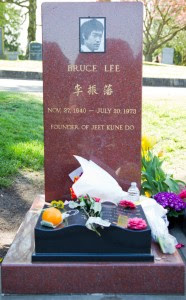
The story begins when Bruce was still training with Professor Yip Man, head of the wing chun school of gung fu, during the only formal martial arts training he received. During the training, Yip Man repeatedly came up to Lee and said, “Loong, relax and calm your mind. Forget about yourself and follow the opponent’s movements. Let your mind, the basic reality, do the counter-movement without any interfering deliberation. Above all, learn the art of detachment.”
These were abstract concepts to the young Lee, and he experienced great frustration and consternation. He would tell himself to relax, but instinctively do something to contradict his will. Seeing his anxiety, Yip Man returned again and said, “Loong, preserve yourself by following the natural bend of things and don’t interfere. Remember to never assert yourself against nature; never be in frontal opposition to any problems, but control it by swinging with it.” After a time, the instructor told his youthful student to stop practicing for a week, go home, get away from the routines and reflect.
Lee spent a week practicing and meditating, but felt no closer to what he was seeking. In an attempt to clear his mind, he went out sailing by himself on a junk in the harbor. Here’s what happened next, in Lee’s own words:
“On the sea I thought of all my past training and got mad at myself and punched the water! Right then—at that moment—a thought suddenly struck me; was not the water the very essence of gun fu? Hadn’t the water just now illustrated to me the principle of gung fu? I struck it, but it did not suffer hurt. Again I struck it with all my might—yet it was not wounded! I then tried to grasp a handful of it, but this proved impossible. This water, the softest substance in the world, which could be contained in the smallest jar, only seemed weak. In reality, it could penetrate the hardest substance in the world. That was it! I wanted to be like the nature of water.
“Suddenly a bird flew by and cast its reflection on the water. Right then as I was absorbing myself with the lessons of the water, another mystic sense of hidden meaning revealed itself to me; should not the thoughts and emotions I had when in front of an opponent pass like the reflection of the bird flying over the water? That was exactly what Professor Yip meant by being detached—not being without emotion or feeling, but being one in whom feeling was not sticky or blocked. Therefore in order to control myself I must first accept myself by going with and not against my nature.”
After his epiphany, Lee just lay there and let the boat drift freely, feeling united with Tao. He possessed a feeling in which opposition had become mutually cooperative instead of mutually exclusive, and he lost all feeling of conflict in his mind. That experience on the water was a seminal moment and became a defining concept later in life when Lee went on to found Jeet Kune Do (JKD). And that is where we can learn much about how we can best respond to challenges, setbacks, and the mindset necessary for success. Because here’s the thing:
At some point, you’re going to get a bad medical diagnosis, lose a loved one, get fired, be in a horrific accident, go bankrupt, be jilted by the love of your life, have your business fail, or other similar event. And mostly likely, a lot more than one.
Like you, I hate to see a kid get leukemia, parents unable to have children, entrepreneurs get their dreams dashed, or a child lose a parent. But these things are all part of this tapestry called life and they happen to some of us everyday.
I’m not going to tell you it’s easy. Often it is not. Sometimes we are tested to the limits of our fortitude. It is times such as these that we must be like water. Bend, adapt, reshape and reform. Find new directions or different levels. You have to stop trying to assert yourself with frontal opposition against nature, but by bending with it.
Sometimes we don’t have a choice in the events that happen to us. But we always have the choice in how we respond to those events. So what is the area in your life right now, where you must be like water?
Sensei Black
Aikido Roots
Aikido is a relatively new martial art dating from the 1920s when it's founder Morihei Ushiba (O-Sensei) or "Honored Teacher. ",began to develop what he eventually came to call Aikido, "the way of harmony with ki."
Aikido,Judo,Kendo,Daito-ryu, and Karate (Okinawan rather than Japanese) are all gendai "(modern") styles rooted in koryu, the traditional ( "old flow") schools of classical budo. The division and modern is the end of the Shogunate and the Meji restoration of 1868.
It is rooted in the Japanese samurai warrior tradition aand incorporates concepts from swordsmanship. It is based also based on Ueshiba's nearly 20- year study of Daito-ryu jujutsu which was gentled and transformed by his attachment to the Omoto religion and it's celebration of life, creation, and loving protection of others.
Aikido replaced the maiming and destruction of the classical battlefield martial arts with control and compassion. It's goal is to subdue and control a situation, protecting both the attacker and the attacked. Aikido is, for example, the only martial art recommended to the parents of abusive children.
Ideally the Aikidoist does not punch or kick to injure or harm unnecessarily, does not block or resist attacks but blends with, redirects and transforms the attackers energy, maintaining the flow. The result is devastating softness, invisible technique and an art that makes no sense to most observers accustomed to force against force.
There are certainly more questions about the how's and whys of Aikido but this will give the curious a basic understanding.
Sensei Black
Core Principals
Among the classical martial arts there are some which are intended specifically as systems of combat; their goal is to subdue enemies by the use of physical force.
Other martial arts, are however, are supposed to be different . Their core principle is that real victory means never needing to use physical force, because you are" so strong inside that you don't have any need to demonstrate your power."
In these systems, the best outcome for encounters of potential conflict is an honorable resolution without using any of the physical techniques of that particular martial art. Notice, that I stress "honorable." Avoiding the use of physical force by running away, or by lying, or toadying, is not honorable, and none of these actions is an acceptable choice except in the rarest of life-or -death situations. We have many excellent schools and teachers of these arts in the Western world today. But I see two problems in the way that their students are being prepared for life.
Most of the students don't appear to be learning that core principle. So far as anyone can tell by observing their behavior, their primary goal is to win in combat, whether real or staged, just as if their chosen discipline were one of the killing arts.
Even when the principle is remembered and learned the students are not being taught what to do instead of physical moves. Consider Sun-Tzu's famous statement that "the highest skill is not winning one hundred victories in battle but subduing the enemy without fighting" don't try using physical force until you've tried talking and that has failed" is an accurate statement but is it enough . No one would tell a student: "Just use some kind of effective physical force until the opponent is subdued" and consider that enough. Making it up as you go along is not a martial art.
Sensei Black
The Basic Basics
We should always return to the basics. Prayer, Affirmations, Effective Questions, Meditation and Martial Arts and Sports are five incredible tools that we all need to consider. They are invaluable and indispensable. I believe that the Universal Spirit has rendered unto each and every one of us the responsibility of making choices and therefore, determined free will as our greatest power. I consider the affirmation principle to be the most precious thing that I have ever learned regarding free will. I have studied it, practiced it and have taught it for more than half my life and I can truly say that it is the secret elixir to life and success.
And, for this… I am truly thankful and grateful.
Sensei Black
Beating the Competition
" Don't bother just to be better than your contemporaries or predecessors.
Try to be better than yourself."
Sports has given us the concept of "personal best," the idea that our most
important competition is with ourselves.
Can we do better today than we did yesterday?
Can we do even better tomorrow?
Competing with ourselves is healthier than competing with others. For one
thing, there's no way to cheat. For another, there can be no sore losers-
if were competing against ourselves.
I'll keep track of my personal best so that I can try to "be better than
myself.
Sensei Black
Simplifying Aikido Basics
No matter what martial art you are involved in, basics are very important. And, as far as Aikido is concerned, basics are extremely important.
Miyamoto Mushashi teaches the strategy of simplicity and the economy of movement. He is a must read for anyone in martial arts.
I think Aikido does this through it’s teachings of having a clear mind. When you enter a dojo (training hall) we need to learn to turn-off the outside world to better learn to be in a state of “Mushin”- a mind that is completely clear of any thoughts.
Unconsciously, “Mushin” will help you learn the economy of movement and maintaining a calm mind during your Randori ( free flowing Aikido). By maintaining a state of clam throughout your movements you will easily be able to sense your opponent’s intentions.
Sometimes Aikido is misunderstood because exercises that we practice in how to harmonize or blend with Uke ( opponent ) look somewhat foreign. These exercises are not techniques thus the misinterpretation of looking phony or pre-arranged. They are only meant to unify movements into one flow without clashing with someone. And, as a result, you can execute techniques without using muscle. Thus the question of Aikido’s authenticity.
In most Arts the body’s center of balance comes up from the toes, through the balls of your feet, uniting our knees, hips and core. This is the beginning stages of centering yourself for balance. This allows us to learn the timing of Irimi ( entering) and Ten-kan ( pivoting around ) and more importantly Ma-Ai ( appropriate distance such that a technique can be done well ). There are various kinds of timing that we need to deal with such as blending your flow of power during an attack or when you are being pushed or pulled and also the importance of meeting an attack.
In any fighting situation we need to learn to control our breathing which will influence whether we become fatigued or so we don’t run out of gas. And breathing properly also teaches us to focus our power at the appropriate time.
Aikido’s design is circular and should never follow a complete straight line without some kind of Tai-Sabaki ( lateral movement ). Aikido’s philosophy: Avoid using strength and muscle.
Study the old to understand the new.
Sensei Black
Living your Life
How often do we ask ourselves as if waking from a dream, “where has the time gone? What happened to yesterday? What happened to last week? Last month? Last year?” Our lives are all we have on earth and yet how many days do we let slip by without living them as fully as we might?
Living every day doesn’t mean trying to achieve something significant every moment that we are conscious. No one could sustain a life like that. It just means doing something each day that adds value to our lives and mostly the lives of others. “I will do something today that will make me feel that I have really lived it!”
Sensei Black
The Basic Concept of Aikido
The basic concept of Aikido is to harmonize and make it a foundation of our daily lives. Most importantly, with those that confront us, attack us verbally or physically and maybe try to abuse us mentally when they are not invited in to our personal space. So, to harmonize with someone who is doing all of this to us is a concept so foreign to most North Americans that most just dismiss Aikido.
But, when you live it through daily practice it will most certainly open your mind to a whole new way in how you view aggression.
O Sensei, the founder of Aikido, believed that if one practiced this philosophy the world would be a safer place to live with less conflicts and disputes. And, maybe one day, this would contribute to national harmony and by extension, world peace.
Aikido is not meant to attack others. It is a self-defense martial art. It allows us to harmonize with the aggressor and respond accordingly. It is said that O Sensei felt the anger of the aggressor before he attacked. That the intent will always precede any attack. This is what makes the individual techniques so effective because it is the blending that is the lesson to learn here.
Sensei Black
Mushin
When you enter the training hall, you should leave the outside world at the front door. We all need to learn to practice the art of “Mushin”- A mind that is free of outside thoughts.
Perfection of Aikido is only achieved through repetition. Repeating the same movements over and over again so that we do the movement without conscious thoughts.
You see, mushin is something that is done unconsciously ( no mind ). When you have achieved this, then you have arrived at moving your mind and not your feet. This state of mind is when you truly understand Aikido.
Sensei Black
Samurai
The word samurai literally means henchmen or retainer or another is to
serve.
The earliest use of the word comes attached to low-ranking civil servants
in old- time Japan- a warrior class that began as a brawling rabble in the
early Middle Ages, before the Knightly class began to earn favor, it's own
feudal domains and with them, a yearning for high culture.
As the life of
a successful warrior garnered spoils and wealth,the trappings of these
military men became more ostentatious. So,too,did their personal battle
with the nature of loyalty itself.
Throughout the history of the of the Samurai, the question of loyalty is
constant, incessant refrain. Loyalty to whom- this or that pretender, this
or that general? Loyalty to what - the imperial institution, it's martial
representative, the status quo, or even the idea of a new order, if only the
current order could be overturned?
A samurai was supposedly a perfect soldier, keeping to a draconian martial
code that was set down much later as Bushido-the way of the warrior'.
Honour, bravery, and prowess in battle were valued above life itself.
One
of the most famous samurai was Kusunoki Masashige- a statue of him on a
horse has a prominent position outside today's Imperial Palace in Tokyo.
Ordered into a battle he knew he could not win, he still led the charge, and
died proclaiming he wished he had seven live to give for his country. He
later became an unofficial emblem of the kamikaze pilots in the Second
World War.
The Samurai are to the Japanese as Cowboys are to westerners a lot factual
and a whole lot more fictional. But what ever people chose to
believe we first to understand that there is a whole lot more to Japan
than just the samurai. But samurai have shaped so much of Japan that is
impossible to see Japan without them.
Different Paths
Aikido will have a different meaning and a different impact on anyone who practices it.
For me, it was a passion to learn a new martial art without the politics of a competitive body. For you, it will be a different reason.
Masamunekan dojo will provide an environment in which to practice with mutual respect, safety and very practical instruction.
Aikido is a great workout but, it is more than a “ way to stay in shape “. Morihei Ueshiba, the founder of Aikido, wrote, “ Those who persevere will find truth in this. Aikido uses the body to train the mind and clam the spirit”.
Just this alone should be enough to want to learn this modern Martial Art.
It is an art whose ultimate goal is the evolution of the mind, the development of the spirit and the harmonization of the body.
Please come by for a visit. We would love to answer any of your questions.
Sensei Black - August 14, 2012
Personal Space
Personal boundaries are the imaginary lines you draw around yourself
that no one should cross either physically or emotionally unless invited in.
You/ we are all entitled to respect, privacy, decency, kindness, love, truth
and honor to name but a few rights. If people invade your space, cross the lines,
blur the boundaries, you are entitled to defend yourself and say
“No, I will not put up with this.”
But you need to draw the lines. Most importantly, you need to know what
they are and where they are. Aikido teaches you this.
Setting personal boundaries means you don’t have to be scared of other
people anymore because you will have a clear idea of what you
will put up with and what you will not put up with. Once someone crosses
the lines between appropriate and inappropriate behavior, it gets real easy to say, “No”.
Setting boundaries enables us to resist aggressive people.
Sensei
Circular Motion /Body Movement
By far the most important type of movement in aikido is the circular
displacement of your body especially when under severe physical attack.
This type of motion has always been one of the most important lessons in
martial arts especially to martial artists in competitive competition
because it teaches the counter attacker to evade a direct attack while
strategically positioning themselves to evade and then counter attack.
This circular motion used may be performed in two basic ways: either by
keeping both feet in light contact with the ground as you turn your hips
or by using one foot as the fulcrum as the other foot slides smoothly
around it, either moving forward or backwards.
Learning this movement will help your Aikido become a moving art. . . . It
is much harder to hit a moving target.
Sensei
Special Feature of Aikido
One special feature of aikido training is to learn to defend yourself
against multiple attackers this practice is called jiyuwaza. . .
It is a key part of training once the student shows proficiency in their
basics.
This practice becomes part of the higher ranks daily practice and is often
referred to as Randori literal meaning "chaos" the exercises improve the
persons ability to intuitively perform under extreme pressure.
It teaches strategic choices of techniques and how they reposition
multiple attackers to better position themselves against the other
attackers coming from the side or from behind.
Mental Training
Aikido training is mental as well as physical, emphasizing the ability to
relax the mind and body even under the stress of dangerous situations.
This is necessary to enable the student to perform entering and blending
movements that underlie aikido techniques,where an attack is met with
confidence and directness.
Ueshiba Sensei teachings was that one "must be willing to receive 90% of
an opponent's attack and stare death in the face" in order to understand
there should be no hesitation when executing a technique.
As a martial art we should not only be concerned with proficiency of our
art but with the betterment of daily life, this mental aspect is of key
importance when training in aikido.

Aikido and Bushido
Aikido is the Japanese martial art that emphasizes the principles of harmony and Ki ( internal energy ). It is an art who’s ultimate goal is the evolution of the mind, the development of the spirit and the harmonization of the body.
We not only teach the physical principles of this art but, emphasize the philosophical and cultural teaching called Bushido… The Way of the Samurai.
Ukemi
The ability to fall safely is the most valuable self- defense technique
there is.
Ukemi (rolling) is the most practical, real world self-defense that we
teach. Very few of us get in real fights regularly,but all of us (in
Canada)have to deal with falling or slipping on snow,ice,or we might fall
on stairs-we all will fall at sometime sooner or later but falling is
inevitable and falling is dangerous.
People die everyday from falling down.
I think it's a good idea to learn to do it with some safety, as we say in
Canada, eh?
In Real Life, falls are a far greater daily danger than street attacks.
Consider the data on accidental deaths more people in the U.S. die each
year from falls than die from drowning, fire, choking, poison and firearms
combined. Motor vehicle crashes. (And horizontal falls) beat all others.
Be very sure someday you will fall. . .
Safe falling is one of the most challenging and important skills in
martial arts.
Critical to Aikido Judo Ju-Jutsu, it is rarely taught in Karate. In competition,many techniques are not used because of the dangers of falling.
The Gracies exploited this for years in the Octagon until the rest of the
martial arts world caught on to what they were doing-purposefully taking
opponents untrained in falling violently down to the ground.
But ask yourself this question who is taught to fall safely?
Very few are ever trained to fall safely.
Aikido teaches this skill.
Aikido and Self Defense
Learning self-defense is similar in some ways to insuring something you presently own like an automobile, your house or your house. The chances that you may never have to use say, your house insurance with the possibility that it might burn down is fairly remote. As are the chances that you will ever be violently assaulted. Yet most people insure their homes while surprisingly few people take out a personal insurance in the form of self-defense classes.
There are two ways to investigate self-defense:
- Take a beginner’s program and you can get some idea of what it’s all about. Learn and practice a few of the basic moves or
- You can go into some depth and explore the way practicing martial artists do by joining a recognized dojo.
Surprisingly, in the case of self-defense, a little knowledge is not necessarily a bad thing. If you can defend yourself with confidence and use these techniques as an element of surprise, it can be overwhelmingly effective.
Learning about your own personal space is the first step in self-defense awareness.
Techniques and defenses are drawn from many and multiple sources- aikido, karate, judo, ju jitsu and boxing to name a few.
Many people have asked if Aikido is an effective means of self-defense and do you have to be strong ?
In any martial art, it takes time to develop and it takes time to be proficient. There really are no shortcuts.
Aikido is based on nonresistance. We use the “aggressor’s” energy, strength and power against them in defending ourselves. Aikido does not depend on physical strength.
For this reason, Aikido works for all ages and genders.
Point of Interest: In Japan, it is a requirement of the Tokyo riot police to have their black belt in Aikido in order to be a member of their team. Their motto is to control aggression without inflicting permanent injury. These is the same basic foundation of Aikido.
Sensei Black
Bowing
Attention Beginners: Why do we bow when entering and leaving the dojo?
All martial arts begin and end with courtesy. When you enter the training hall you bow in respect to your fellow practitioners to show appreciation towards them and to be respectful that you have a place to train.
Thank your instructors and training partners for participating and sharing with them.
Sensei Black
Mushin
As a martial art, Aikido relies heavily on the Zen philosophy of empty mind known in Japanese as “Mushin”. This encourages instinctive actions bypassing the need for conscious thought and saving precious moments in conflict situations.
The concept of this thinking is also or can be very practical in our day-to-day lives. And, how many students suggest that they have found an increased ability to deal with unfamiliar or unexpected situations?
“No mind”. Interesting concept.
Enjoy the journey. It’s “work” the trip.
Sensei






